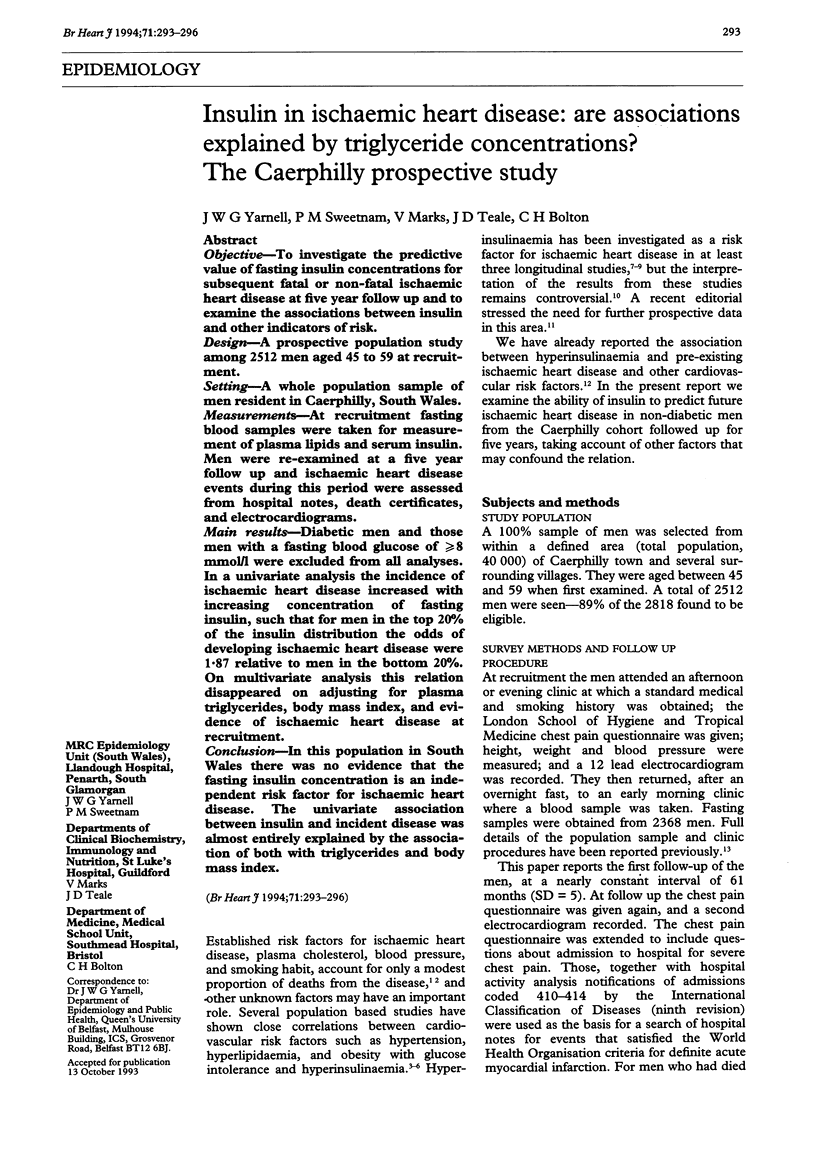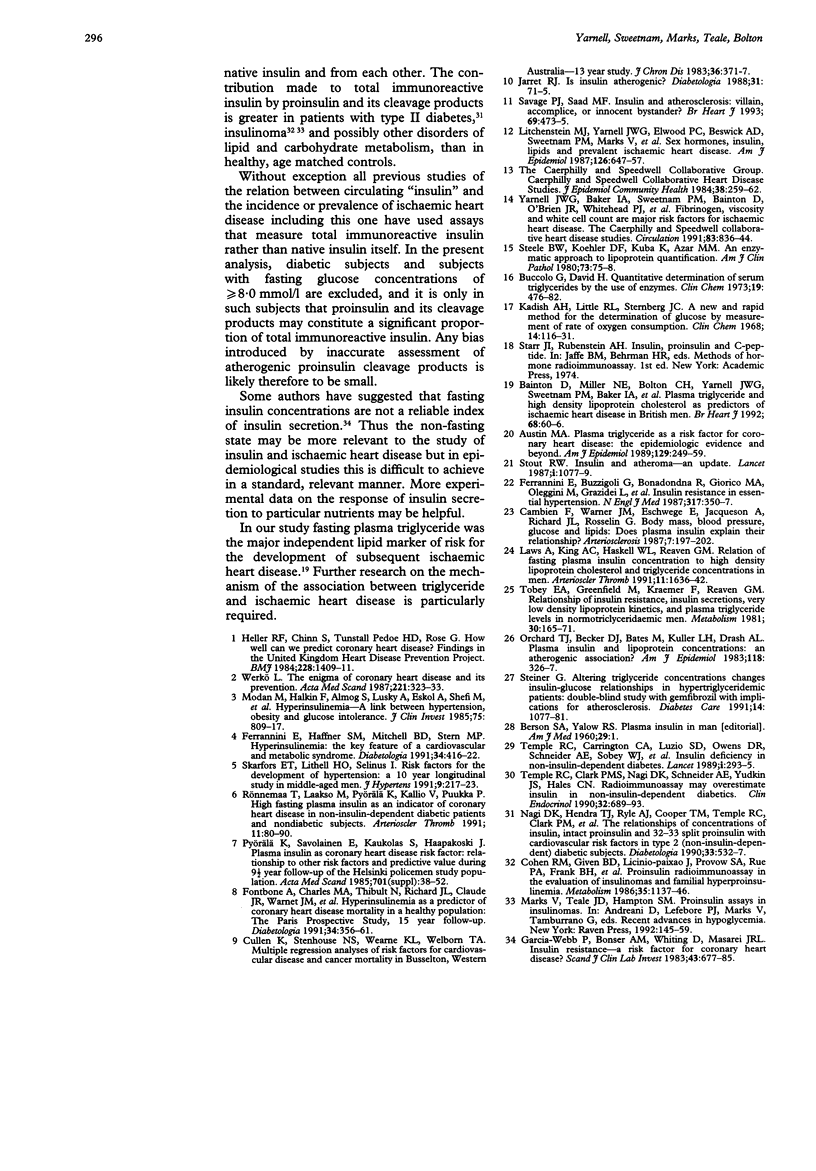Abstract
OBJECTIVE--To investigate the predictive value of fasting insulin concentrations for subsequent fatal or non-fatal ischaemic heart disease at five year follow up and to examine the associations between insulin and other indicators of risk. DESIGN--A prospective population study among 2512 men aged 45 to 59 at recruitment. SETTING--A whole population sample of men resident in Caerphilly, South Wales. MEASUREMENTS--At recruitment fasting blood samples were taken for measurement of plasma lipids and serum insulin. Men were re-examined at a five year follow up and ischaemic heart disease events during this period were assessed from hospital notes, death certificates, and electrocardiograms. MAIN RESULTS--Diabetic men and those men with a fasting blood glucose of > or = 8 mmol/l were excluded from all analyses. In a univariate analysis the incidence of ischaemic heart disease increased with increasing concentration of fasting insulin, such that for men in the top 20% of the insulin distribution the odds of developing ischaemic heart disease were 1.87 relative to men in the bottom 20%. On multivariate analysis this relation disappeared on adjusting for plasma triglycerides, body mass index, and evidence of ischaemic heart disease at recruitment. CONCLUSION--In this population in South Wales there was no evidence that the fasting insulin concentration is an independent risk factor for ischaemic heart disease. The univariate association between insulin and incident disease was almost entirely explained by the association of both with triglycerides and body mass index.
Full text
PDF



Selected References
These references are in PubMed. This may not be the complete list of references from this article.
- Austin M. A. Plasma triglyceride as a risk factor for coronary heart disease. The epidemiologic evidence and beyond. Am J Epidemiol. 1989 Feb;129(2):249–259. doi: 10.1093/oxfordjournals.aje.a115130. [DOI] [PubMed] [Google Scholar]
- Bainton D., Miller N. E., Bolton C. H., Yarnell J. W., Sweetnam P. M., Baker I. A., Lewis B., Elwood P. C. Plasma triglyceride and high density lipoprotein cholesterol as predictors of ischaemic heart disease in British men. The Caerphilly and Speedwell Collaborative Heart Disease Studies. Br Heart J. 1992 Jul;68(1):60–66. doi: 10.1136/hrt.68.7.60. [DOI] [PMC free article] [PubMed] [Google Scholar]
- Bucolo G., David H. Quantitative determination of serum triglycerides by the use of enzymes. Clin Chem. 1973 May;19(5):476–482. [PubMed] [Google Scholar]
- Cambien F., Warnet J. M., Eschwege E., Jacqueson A., Richard J. L., Rosselin G. Body mass, blood pressure, glucose, and lipids. Does plasma insulin explain their relationships? Arteriosclerosis. 1987 Mar-Apr;7(2):197–202. doi: 10.1161/01.atv.7.2.197. [DOI] [PubMed] [Google Scholar]
- Cohen R. M., Given B. D., Licinio-Paixao J., Provow S. A., Rue P. A., Frank B. H., Root M. A., Polonsky K. S., Tager H. S., Rubenstein A. H. Proinsulin radioimmunoassay in the evaluation of insulinomas and familial hyperproinsulinemia. Metabolism. 1986 Dec;35(12):1137–1146. doi: 10.1016/0026-0495(86)90027-2. [DOI] [PubMed] [Google Scholar]
- Cullen K., Stenhouse N. S., Wearne K. L., Welborn T. A. Multiple regression analysis of risk factors for cardiovascular disease and cancer mortality in Busselton, Western Australia--13-year study. J Chronic Dis. 1983;36(5):371–377. doi: 10.1016/0021-9681(83)90169-8. [DOI] [PubMed] [Google Scholar]
- Ferrannini E., Buzzigoli G., Bonadonna R., Giorico M. A., Oleggini M., Graziadei L., Pedrinelli R., Brandi L., Bevilacqua S. Insulin resistance in essential hypertension. N Engl J Med. 1987 Aug 6;317(6):350–357. doi: 10.1056/NEJM198708063170605. [DOI] [PubMed] [Google Scholar]
- Ferrannini E., Haffner S. M., Mitchell B. D., Stern M. P. Hyperinsulinaemia: the key feature of a cardiovascular and metabolic syndrome. Diabetologia. 1991 Jun;34(6):416–422. doi: 10.1007/BF00403180. [DOI] [PubMed] [Google Scholar]
- Fontbonne A., Charles M. A., Thibult N., Richard J. L., Claude J. R., Warnet J. M., Rosselin G. E., Eschwège E. Hyperinsulinaemia as a predictor of coronary heart disease mortality in a healthy population: the Paris Prospective Study, 15-year follow-up. Diabetologia. 1991 May;34(5):356–361. doi: 10.1007/BF00405009. [DOI] [PubMed] [Google Scholar]
- Garcia-Webb P., Bonser A. M., Whiting D., Masarei J. R. Insulin resistance--a risk factor for coronary heart disease? Scand J Clin Lab Invest. 1983 Dec;43(8):677–685. [PubMed] [Google Scholar]
- Heller R. F., Chinn S., Pedoe H. D., Rose G. How well can we predict coronary heart disease? Findings in the United Kingdom Heart Disease Prevention Project. Br Med J (Clin Res Ed) 1984 May 12;288(6428):1409–1411. doi: 10.1136/bmj.288.6428.1409. [DOI] [PMC free article] [PubMed] [Google Scholar]
- Jarrett R. J. Is insulin atherogenic? Diabetologia. 1988 Feb;31(2):71–75. doi: 10.1007/BF00395550. [DOI] [PubMed] [Google Scholar]
- Laws A., King A. C., Haskell W. L., Reaven G. M. Relation of fasting plasma insulin concentration to high density lipoprotein cholesterol and triglyceride concentrations in men. Arterioscler Thromb. 1991 Nov-Dec;11(6):1636–1642. doi: 10.1161/01.atv.11.6.1636. [DOI] [PubMed] [Google Scholar]
- Lichtenstein M. J., Yarnell J. W., Elwood P. C., Beswick A. D., Sweetnam P. M., Marks V., Teale D., Riad-Fahmy D. Sex hormones, insulin, lipids, and prevalent ischemic heart disease. Am J Epidemiol. 1987 Oct;126(4):647–657. doi: 10.1093/oxfordjournals.aje.a114704. [DOI] [PubMed] [Google Scholar]
- Modan M., Halkin H., Almog S., Lusky A., Eshkol A., Shefi M., Shitrit A., Fuchs Z. Hyperinsulinemia. A link between hypertension obesity and glucose intolerance. J Clin Invest. 1985 Mar;75(3):809–817. doi: 10.1172/JCI111776. [DOI] [PMC free article] [PubMed] [Google Scholar]
- Nagi D. K., Hendra T. J., Ryle A. J., Cooper T. M., Temple R. C., Clark P. M., Schneider A. E., Hales C. N., Yudkin J. S. The relationships of concentrations of insulin, intact proinsulin and 32-33 split proinsulin with cardiovascular risk factors in type 2 (non-insulin-dependent) diabetic subjects. Diabetologia. 1990 Sep;33(9):532–537. doi: 10.1007/BF00404140. [DOI] [PubMed] [Google Scholar]
- Orchard T. J., Becker D. J., Bates M., Kuller L. H., Drash A. L. Plasma insulin and lipoprotein concentrations: an atherogenic association? Am J Epidemiol. 1983 Sep;118(3):326–337. doi: 10.1093/oxfordjournals.aje.a113639. [DOI] [PubMed] [Google Scholar]
- PLASMA insulin in man. Am J Med. 1960 Jul;29:1–8. doi: 10.1016/0002-9343(60)90002-4. [DOI] [PubMed] [Google Scholar]
- Pyörälä K., Savolainen E., Kaukola S., Haapakoski J. Plasma insulin as coronary heart disease risk factor: relationship to other risk factors and predictive value during 9 1/2-year follow-up of the Helsinki Policemen Study population. Acta Med Scand Suppl. 1985;701:38–52. doi: 10.1111/j.0954-6820.1985.tb08888.x. [DOI] [PubMed] [Google Scholar]
- Rönnemaa T., Laakso M., Pyörälä K., Kallio V., Puukka P. High fasting plasma insulin is an indicator of coronary heart disease in non-insulin-dependent diabetic patients and nondiabetic subjects. Arterioscler Thromb. 1991 Jan-Feb;11(1):80–90. doi: 10.1161/01.atv.11.1.80. [DOI] [PubMed] [Google Scholar]
- Savage P. J., Saad M. F. Insulin and atherosclerosis: villain, accomplice, or innocent bystander? Br Heart J. 1993 Jun;69(6):473–475. doi: 10.1136/hrt.69.6.473. [DOI] [PMC free article] [PubMed] [Google Scholar]
- Skarfors E. T., Lithell H. O., Selinus I. Risk factors for the development of hypertension: a 10-year longitudinal study in middle-aged men. J Hypertens. 1991 Mar;9(3):217–223. doi: 10.1097/00004872-199103000-00004. [DOI] [PubMed] [Google Scholar]
- Steele B. W., Koehler D. F., Kuba K., Azar M. M. An enzymatic approach to lipoprotein quantification. Am J Clin Pathol. 1980 Jan;73(1):75–78. doi: 10.1093/ajcp/73.1.75. [DOI] [PubMed] [Google Scholar]
- Steiner G. Altering triglyceride concentrations changes insulin-glucose relationships in hypertriglyceridemic patients. Double-blind study with gemfibrozil with implications for atherosclerosis. Diabetes Care. 1991 Nov;14(11):1077–1081. doi: 10.2337/diacare.14.11.1077. [DOI] [PubMed] [Google Scholar]
- Stout R. W. Insulin and atheroma--an update. Lancet. 1987 May 9;1(8541):1077–1079. doi: 10.1016/s0140-6736(87)90495-8. [DOI] [PubMed] [Google Scholar]
- Temple R. C., Carrington C. A., Luzio S. D., Owens D. R., Schneider A. E., Sobey W. J., Hales C. N. Insulin deficiency in non-insulin-dependent diabetes. Lancet. 1989 Feb 11;1(8633):293–295. doi: 10.1016/s0140-6736(89)91306-8. [DOI] [PubMed] [Google Scholar]
- Temple R. C., Clark P. M., Nagi D. K., Schneider A. E., Yudkin J. S., Hales C. N. Radioimmunoassay may overestimate insulin in non-insulin-dependent diabetics. Clin Endocrinol (Oxf) 1990 Jun;32(6):689–693. doi: 10.1111/j.1365-2265.1990.tb00915.x. [DOI] [PubMed] [Google Scholar]
- Tobey T. A., Greenfield M., Kraemer F., Reaven G. M. Relationship between insulin resistance, insulin secretion, very low density lipoprotein kinetics, and plasma triglyceride levels in normotriglyceridemic man. Metabolism. 1981 Feb;30(2):165–171. doi: 10.1016/0026-0495(81)90167-0. [DOI] [PubMed] [Google Scholar]
- Werkö L. The enigma of coronary heart disease and its prevention. Acta Med Scand. 1987;221(4):323–333. doi: 10.1111/j.0954-6820.1987.tb03352.x. [DOI] [PubMed] [Google Scholar]
- Yarnell J. W., Baker I. A., Sweetnam P. M., Bainton D., O'Brien J. R., Whitehead P. J., Elwood P. C. Fibrinogen, viscosity, and white blood cell count are major risk factors for ischemic heart disease. The Caerphilly and Speedwell collaborative heart disease studies. Circulation. 1991 Mar;83(3):836–844. doi: 10.1161/01.cir.83.3.836. [DOI] [PubMed] [Google Scholar]


